

Narrative Writing: A Complete Guide for Teachers and Students
MASTERING THE CRAFT OF NARRATIVE WRITING
Narratives build on and encourage the development of the fundamentals of writing. They also require developing an additional skill set: the ability to tell a good yarn, and storytelling is as old as humanity.
We see and hear stories everywhere and daily, from having good gossip on the doorstep with a neighbor in the morning to the dramas that fill our screens in the evening.
Good narrative writing skills are hard-won by students even though it is an area of writing that most enjoy due to the creativity and freedom it offers.
Here we will explore some of the main elements of a good story: plot, setting, characters, conflict, climax, and resolution . And we will look too at how best we can help our students understand these elements, both in isolation and how they mesh together as a whole.

WHAT IS A NARRATIVE?

A narrative is a story that shares a sequence of events , characters, and themes. It expresses experiences, ideas, and perspectives that should aspire to engage and inspire an audience.
A narrative can spark emotion, encourage reflection, and convey meaning when done well.
Narratives are a popular genre for students and teachers as they allow the writer to share their imagination, creativity, skill, and understanding of nearly all elements of writing. We occasionally refer to a narrative as ‘creative writing’ or story writing.
The purpose of a narrative is simple, to tell the audience a story. It can be written to motivate, educate, or entertain and can be fact or fiction.
A COMPLETE UNIT ON TEACHING NARRATIVE WRITING

Teach your students to become skilled story writers with this HUGE NARRATIVE & CREATIVE STORY WRITING UNIT . Offering a COMPLETE SOLUTION to teaching students how to craft CREATIVE CHARACTERS, SUPERB SETTINGS, and PERFECT PLOTS .
Over 192 PAGES of materials, including:
TYPES OF NARRATIVE WRITING
There are many narrative writing genres and sub-genres such as these.
We have a complete guide to writing a personal narrative that differs from the traditional story-based narrative covered in this guide. It includes personal narrative writing prompts, resources, and examples and can be found here.

As we can see, narratives are an open-ended form of writing that allows you to showcase creativity in many directions. However, all narratives share a common set of features and structure known as “Story Elements”, which are briefly covered in this guide.
Don’t overlook the importance of understanding story elements and the value this adds to you as a writer who can dissect and create grand narratives. We also have an in-depth guide to understanding story elements here .
CHARACTERISTICS OF NARRATIVE WRITING
Narrative structure.
ORIENTATION (BEGINNING) Set the scene by introducing your characters, setting and time of the story. Establish your who, when and where in this part of your narrative
COMPLICATION AND EVENTS (MIDDLE) In this section activities and events involving your main characters are expanded upon. These events are written in a cohesive and fluent sequence.
RESOLUTION (ENDING) Your complication is resolved in this section. It does not have to be a happy outcome, however.
EXTRAS: Whilst orientation, complication and resolution are the agreed norms for a narrative, there are numerous examples of popular texts that did not explicitly follow this path exactly.
NARRATIVE FEATURES
LANGUAGE: Use descriptive and figurative language to paint images inside your audience’s minds as they read.
PERSPECTIVE Narratives can be written from any perspective but are most commonly written in first or third person.
DIALOGUE Narratives frequently switch from narrator to first-person dialogue. Always use speech marks when writing dialogue.
TENSE If you change tense, make it perfectly clear to your audience what is happening. Flashbacks might work well in your mind but make sure they translate to your audience.
THE PLOT MAP

This graphic is known as a plot map, and nearly all narratives fit this structure in one way or another, whether romance novels, science fiction or otherwise.
It is a simple tool that helps you understand and organise a story’s events. Think of it as a roadmap that outlines the journey of your characters and the events that unfold. It outlines the different stops along the way, such as the introduction, rising action, climax, falling action, and resolution, that help you to see how the story builds and develops.
Using a plot map, you can see how each event fits into the larger picture and how the different parts of the story work together to create meaning. It’s a great way to visualize and analyze a story.
Be sure to refer to a plot map when planning a story, as it has all the essential elements of a great story.
THE 5 KEY STORY ELEMENTS OF A GREAT NARRATIVE (6-MINUTE TUTORIAL VIDEO)
This video we created provides an excellent overview of these elements and demonstrates them in action in stories we all know and love.

HOW TO WRITE A NARRATIVE

Now that we understand the story elements and how they come together to form stories, it’s time to start planning and writing your narrative.
In many cases, the template and guide below will provide enough details on how to craft a great story. However, if you still need assistance with the fundamentals of writing, such as sentence structure, paragraphs and using correct grammar, we have some excellent guides on those here.
USE YOUR WRITING TIME EFFECTIVELY: Maximize your narrative writing sessions by spending approximately 20 per cent of your time planning and preparing. This ensures greater productivity during your writing time and keeps you focused and on task.
Use tools such as graphic organizers to logically sequence your narrative if you are not a confident story writer. If you are working with reluctant writers, try using narrative writing prompts to get their creative juices flowing.
Spend most of your writing hour on the task at hand, don’t get too side-tracked editing during this time and leave some time for editing. When editing a narrative, examine it for these three elements.
- Spelling and grammar ( Is it readable?)
- Story structure and continuity ( Does it make sense, and does it flow? )
- Character and plot analysis. (Are your characters engaging? Does your problem/resolution work? )
1. SETTING THE SCENE: THE WHERE AND THE WHEN

The story’s setting often answers two of the central questions in the story, namely, the where and the when. The answers to these two crucial questions will often be informed by the type of story the student is writing.
The story’s setting can be chosen to quickly orient the reader to the type of story they are reading. For example, a fictional narrative writing piece such as a horror story will often begin with a description of a haunted house on a hill or an abandoned asylum in the middle of the woods. If we start our story on a rocket ship hurtling through the cosmos on its space voyage to the Alpha Centauri star system, we can be reasonably sure that the story we are embarking on is a work of science fiction.
Such conventions are well-worn clichés true, but they can be helpful starting points for our novice novelists to make a start.
Having students choose an appropriate setting for the type of story they wish to write is an excellent exercise for our younger students. It leads naturally onto the next stage of story writing, which is creating suitable characters to populate this fictional world they have created. However, older or more advanced students may wish to play with the expectations of appropriate settings for their story. They may wish to do this for comic effect or in the interest of creating a more original story. For example, opening a story with a children’s birthday party does not usually set up the expectation of a horror story. Indeed, it may even lure the reader into a happy reverie as they remember their own happy birthday parties. This leaves them more vulnerable to the surprise element of the shocking action that lies ahead.
Once the students have chosen a setting for their story, they need to start writing. Little can be more terrifying to English students than the blank page and its bare whiteness stretching before them on the table like a merciless desert they must cross. Give them the kick-start they need by offering support through word banks or writing prompts. If the class is all writing a story based on the same theme, you may wish to compile a common word bank on the whiteboard as a prewriting activity. Write the central theme or genre in the middle of the board. Have students suggest words or phrases related to the theme and list them on the board.
You may wish to provide students with a copy of various writing prompts to get them started. While this may mean that many students’ stories will have the same beginning, they will most likely arrive at dramatically different endings via dramatically different routes.

A bargain is at the centre of the relationship between the writer and the reader. That bargain is that the reader promises to suspend their disbelief as long as the writer creates a consistent and convincing fictional reality. Creating a believable world for the fictional characters to inhabit requires the student to draw on convincing details. The best way of doing this is through writing that appeals to the senses. Have your student reflect deeply on the world that they are creating. What does it look like? Sound like? What does the food taste like there? How does it feel like to walk those imaginary streets, and what aromas beguile the nose as the main character winds their way through that conjured market?
Also, Consider the when; or the time period. Is it a future world where things are cleaner and more antiseptic? Or is it an overcrowded 16th-century London with human waste stinking up the streets? If students can create a multi-sensory installation in the reader’s mind, then they have done this part of their job well.
Popular Settings from Children’s Literature and Storytelling
- Fairytale Kingdom
- Magical Forest
- Village/town
- Underwater world
- Space/Alien planet
2. CASTING THE CHARACTERS: THE WHO
Now that your student has created a believable world, it is time to populate it with believable characters.
In short stories, these worlds mustn’t be overpopulated beyond what the student’s skill level can manage. Short stories usually only require one main character and a few secondary ones. Think of the short story more as a small-scale dramatic production in an intimate local theater than a Hollywood blockbuster on a grand scale. Too many characters will only confuse and become unwieldy with a canvas this size. Keep it simple!
Creating believable characters is often one of the most challenging aspects of narrative writing for students. Fortunately, we can do a few things to help students here. Sometimes it is helpful for students to model their characters on actual people they know. This can make things a little less daunting and taxing on the imagination. However, whether or not this is the case, writing brief background bios or descriptions of characters’ physical personality characteristics can be a beneficial prewriting activity. Students should give some in-depth consideration to the details of who their character is: How do they walk? What do they look like? Do they have any distinguishing features? A crooked nose? A limp? Bad breath? Small details such as these bring life and, therefore, believability to characters. Students can even cut pictures from magazines to put a face to their character and allow their imaginations to fill in the rest of the details.
Younger students will often dictate to the reader the nature of their characters. To improve their writing craft, students must know when to switch from story-telling mode to story-showing mode. This is particularly true when it comes to character. Encourage students to reveal their character’s personality through what they do rather than merely by lecturing the reader on the faults and virtues of the character’s personality. It might be a small relayed detail in the way they walk that reveals a core characteristic. For example, a character who walks with their head hanging low and shoulders hunched while avoiding eye contact has been revealed to be timid without the word once being mentioned. This is a much more artistic and well-crafted way of doing things and is less irritating for the reader. A character who sits down at the family dinner table immediately snatches up his fork and starts stuffing roast potatoes into his mouth before anyone else has even managed to sit down has revealed a tendency towards greed or gluttony.
Understanding Character Traits
Again, there is room here for some fun and profitable prewriting activities. Give students a list of character traits and have them describe a character doing something that reveals that trait without ever employing the word itself.
It is also essential to avoid adjective stuffing here. When looking at students’ early drafts, adjective stuffing is often apparent. To train the student out of this habit, choose an adjective and have the student rewrite the sentence to express this adjective through action rather than telling.
When writing a story, it is vital to consider the character’s traits and how they will impact the story’s events. For example, a character with a strong trait of determination may be more likely to overcome obstacles and persevere. In contrast, a character with a tendency towards laziness may struggle to achieve their goals. In short, character traits add realism, depth, and meaning to a story, making it more engaging and memorable for the reader.
Popular Character Traits in Children’s Stories
- Determination
- Imagination
- Perseverance
- Responsibility
We have an in-depth guide to creating great characters here , but most students should be fine to move on to planning their conflict and resolution.
3. NO PROBLEM? NO STORY! HOW CONFLICT DRIVES A NARRATIVE

This is often the area apprentice writers have the most difficulty with. Students must understand that without a problem or conflict, there is no story. The problem is the driving force of the action. Usually, in a short story, the problem will center around what the primary character wants to happen or, indeed, wants not to happen. It is the hurdle that must be overcome. It is in the struggle to overcome this hurdle that events happen.
Often when a student understands the need for a problem in a story, their completed work will still not be successful. This is because, often in life, problems remain unsolved. Hurdles are not always successfully overcome. Students pick up on this.
We often discuss problems with friends that will never be satisfactorily resolved one way or the other, and we accept this as a part of life. This is not usually the case with writing a story. Whether a character successfully overcomes his or her problem or is decidedly crushed in the process of trying is not as important as the fact that it will finally be resolved one way or the other.
A good practical exercise for students to get to grips with this is to provide copies of stories and have them identify the central problem or conflict in each through discussion. Familiar fables or fairy tales such as Three Little Pigs, The Boy Who Cried Wolf, Cinderella, etc., are great for this.
While it is true that stories often have more than one problem or that the hero or heroine is unsuccessful in their first attempt to solve a central problem, for beginning students and intermediate students, it is best to focus on a single problem, especially given the scope of story writing at this level. Over time students will develop their abilities to handle more complex plots and write accordingly.
Popular Conflicts found in Children’s Storytelling.
- Good vs evil
- Individual vs society
- Nature vs nurture
- Self vs others
- Man vs self
- Man vs nature
- Man vs technology
- Individual vs fate
- Self vs destiny
Conflict is the heart and soul of any good story. It’s what makes a story compelling and drives the plot forward. Without conflict, there is no story. Every great story has a struggle or a problem that needs to be solved, and that’s where conflict comes in. Conflict is what makes a story exciting and keeps the reader engaged. It creates tension and suspense and makes the reader care about the outcome.
Like in real life, conflict in a story is an opportunity for a character’s growth and transformation. It’s a chance for them to learn and evolve, making a story great. So next time stories are written in the classroom, remember that conflict is an essential ingredient, and without it, your story will lack the energy, excitement, and meaning that makes it truly memorable.
4. THE NARRATIVE CLIMAX: HOW THINGS COME TO A HEAD!

The climax of the story is the dramatic high point of the action. It is also when the struggles kicked off by the problem come to a head. The climax will ultimately decide whether the story will have a happy or tragic ending. In the climax, two opposing forces duke things out until the bitter (or sweet!) end. One force ultimately emerges triumphant. As the action builds throughout the story, suspense increases as the reader wonders which of these forces will win out. The climax is the release of this suspense.
Much of the success of the climax depends on how well the other elements of the story have been achieved. If the student has created a well-drawn and believable character that the reader can identify with and feel for, then the climax will be more powerful.
The nature of the problem is also essential as it determines what’s at stake in the climax. The problem must matter dearly to the main character if it matters at all to the reader.
Have students engage in discussions about their favorite movies and books. Have them think about the storyline and decide the most exciting parts. What was at stake at these moments? What happened in your body as you read or watched? Did you breathe faster? Or grip the cushion hard? Did your heart rate increase, or did you start to sweat? This is what a good climax does and what our students should strive to do in their stories.
The climax puts it all on the line and rolls the dice. Let the chips fall where the writer may…
Popular Climax themes in Children’s Stories
- A battle between good and evil
- The character’s bravery saves the day
- Character faces their fears and overcomes them
- The character solves a mystery or puzzle.
- The character stands up for what is right.
- Character reaches their goal or dream.
- The character learns a valuable lesson.
- The character makes a selfless sacrifice.
- The character makes a difficult decision.
- The character reunites with loved ones or finds true friendship.
5. RESOLUTION: TYING UP LOOSE ENDS
After the climactic action, a few questions will often remain unresolved for the reader, even if all the conflict has been resolved. The resolution is where those lingering questions will be answered. The resolution in a short story may only be a brief paragraph or two. But, in most cases, it will still be necessary to include an ending immediately after the climax can feel too abrupt and leave the reader feeling unfulfilled.
An easy way to explain resolution to students struggling to grasp the concept is to point to the traditional resolution of fairy tales, the “And they all lived happily ever after” ending. This weather forecast for the future allows the reader to take their leave. Have the student consider the emotions they want to leave the reader with when crafting their resolution.
While the action is usually complete by the end of the climax, it is in the resolution that if there is a twist to be found, it will appear – think of movies such as The Usual Suspects. Pulling this off convincingly usually requires considerable skill from a student writer. Still, it may well form a challenging extension exercise for those more gifted storytellers among your students.
Popular Resolutions in Children’s Stories
- Our hero achieves their goal
- The character learns a valuable lesson
- A character finds happiness or inner peace.
- The character reunites with loved ones.
- Character restores balance to the world.
- The character discovers their true identity.
- Character changes for the better.
- The character gains wisdom or understanding.
- Character makes amends with others.
- The character learns to appreciate what they have.
Once students have completed their story, they can edit for grammar, vocabulary choice, spelling, etc., but not before!
As mentioned, there is a craft to storytelling, as well as an art. When accurate grammar, perfect spelling, and immaculate sentence structures are pushed at the outset, they can cause storytelling paralysis. For this reason, it is essential that when we encourage the students to write a story, we give them license to make mechanical mistakes in their use of language that they can work on and fix later.
Good narrative writing is a very complex skill to develop and will take the student years to become competent. It challenges not only the student’s technical abilities with language but also her creative faculties. Writing frames, word banks, mind maps, and visual prompts can all give valuable support as students develop the wide-ranging and challenging skills required to produce a successful narrative writing piece. But, at the end of it all, as with any craft, practice and more practice is at the heart of the matter.
TIPS FOR WRITING A GREAT NARRATIVE
- Start your story with a clear purpose: If you can determine the theme or message you want to convey in your narrative before starting it will make the writing process so much simpler.
- Choose a compelling storyline and sell it through great characters, setting and plot: Consider a unique or interesting story that captures the reader’s attention, then build the world and characters around it.
- Develop vivid characters that are not all the same: Make your characters relatable and memorable by giving them distinct personalities and traits you can draw upon in the plot.
- Use descriptive language to hook your audience into your story: Use sensory language to paint vivid images and sequences in the reader’s mind.
- Show, don’t tell your audience: Use actions, thoughts, and dialogue to reveal character motivations and emotions through storytelling.
- Create a vivid setting that is clear to your audience before getting too far into the plot: Describe the time and place of your story to immerse the reader fully.
- Build tension: Refer to the story map earlier in this article and use conflict, obstacles, and suspense to keep the audience engaged and invested in your narrative.
- Use figurative language such as metaphors, similes, and other literary devices to add depth and meaning to your narrative.
- Edit, revise, and refine: Take the time to refine and polish your writing for clarity and impact.
- Stay true to your voice: Maintain your unique perspective and style in your writing to make it your own.
NARRATIVE WRITING EXAMPLES (Student Writing Samples)
Below are a collection of student writing samples of narratives. Click on the image to enlarge and explore them in greater detail. Please take a moment to read these creative stories in detail and the teacher and student guides which highlight some of the critical elements of narratives to consider before writing.
Please understand these student writing samples are not intended to be perfect examples for each age or grade level but a piece of writing for students and teachers to explore together to critically analyze to improve student writing skills and deepen their understanding of story writing.
We recommend reading the example either a year above or below, as well as the grade you are currently working with, to gain a broader appreciation of this text type.

NARRATIVE WRITING PROMPTS (Journal Prompts)
When students have a great journal prompt, it can help them focus on the task at hand, so be sure to view our vast collection of visual writing prompts for various text types here or use some of these.
- On a recent European trip, you find your travel group booked into the stunning and mysterious Castle Frankenfurter for a single night… As night falls, the massive castle of over one hundred rooms seems to creak and groan as a series of unexplained events begin to make you wonder who or what else is spending the evening with you. Write a narrative that tells the story of your evening.
- You are a famous adventurer who has discovered new lands; keep a travel log over a period of time in which you encounter new and exciting adventures and challenges to overcome. Ensure your travel journal tells a story and has a definite introduction, conflict and resolution.
- You create an incredible piece of technology that has the capacity to change the world. As you sit back and marvel at your innovation and the endless possibilities ahead of you, it becomes apparent there are a few problems you didn’t really consider. You might not even be able to control them. Write a narrative in which you ride the highs and lows of your world-changing creation with a clear introduction, conflict and resolution.
- As the final door shuts on the Megamall, you realise you have done it… You and your best friend have managed to sneak into the largest shopping centre in town and have the entire place to yourselves until 7 am tomorrow. There is literally everything and anything a child would dream of entertaining themselves for the next 12 hours. What amazing adventures await you? What might go wrong? And how will you get out of there scot-free?
- A stranger walks into town… Whilst appearing similar to almost all those around you, you get a sense that this person is from another time, space or dimension… Are they friends or foes? What makes you sense something very strange is going on? Suddenly they stand up and walk toward you with purpose extending their hand… It’s almost as if they were reading your mind.
NARRATIVE WRITING VIDEO TUTORIAL

Teaching Resources
Use our resources and tools to improve your student’s writing skills through proven teaching strategies.
When teaching narrative writing, it is essential that you have a range of tools, strategies and resources at your disposal to ensure you get the most out of your writing time. You can find some examples below, which are free and paid premium resources you can use instantly without any preparation.
FREE Narrative Graphic Organizer

THE STORY TELLERS BUNDLE OF TEACHING RESOURCES

A MASSIVE COLLECTION of resources for narratives and story writing in the classroom covering all elements of crafting amazing stories. MONTHS WORTH OF WRITING LESSONS AND RESOURCES, including:
NARRATIVE WRITING CHECKLIST BUNDLE

OTHER GREAT ARTICLES ABOUT NARRATIVE WRITING

Narrative Writing for Kids: Essential Skills and Strategies

7 Great Narrative Lesson Plans Students and Teachers Love

Top 7 Narrative Writing Exercises for Students

How to Write a Scary Story
WANT ACCESS TO MY FREE TEACHER RESOURCE LIBRARY?
One room schoolhouse.
Once Upon a
EXCITE | ENGAGE | EDUCATE
- Apr 10, 2022
Using Plot Diagrams to Improve Students' Narrative Writing
Updated: Oct 16, 2022

Plot diagrams are one of the most underutilized graphic organizers (in my humble opinion) . In case you aren't familiar with plot diagrams OR story maps, they are graphic organizers that help students outline the flow of a story.
There are two basic versions of plot diagrams-the more primary version called a "story map" and the more advanced plot diagram. Both versions essentially do the same thing. They help students map out the movement of a story from beginning to end; however, plot diagrams are more detailed and often include additional information indicative of a longer, more complex stories or chapter books.

TEACHING NARRATIVE STORY STRUCTURE WITH STORY MAPS & PLOT DIAGRAMS
Teaching story structure with story maps and plot diagrams makes introducing or expanding on story elements so much easier! There are so many mini-lessons to be taught through either one of these graphic organizers that you can LITERALLY have a week or more worth of meaningful and engaging lessons that set students up for success now as well as in the future.
STORY MAP MINI-LESSONS (PRIMARY-LEVEL STUDENTS)
For reading:
Text features
Event order
Identifying key vocabulary
For writing:
Brainstorming
Characters in "your" story
Setting in "your" story
Event order in "your" story
Climax in "your" story
Identifying key vocabulary for "your" story & where to find the words that "you" need around the classroom (word wall, personal dictionary, in a mentor text, etc.)
Matching illustrations to "your" story
Using order words
Introduction sentence
Conclusion sentence
Sentence structure
Writing Process (proof-reading, editing, publishing, sharing)
PLOT DIAGRAM MINI-LESSONS (UPPER ELEMENTARY-LEVEL STUDENTS)
Author's craft
Figurative language
Characters; including protagonist, antagonist, and supporting characters
Setting; including the different settings where important events take place, the time period/era
Sequence of events and how a single action by a character can effect the trajectory of the entire story
Climax versus resolution
The importance of word choice for setting the tone of the story
Author's purpose
Key events versus transitional (insignificant) events
Character development in "your" story
Setting & tone in "your" story
Identifying and implementing figurative language and author's craft "moves" in "your" story
Using descriptive language to illustrate "your" story in the mind of your reader
Signifying the passing of time WITHOUT using numbered order words (first, second, third, last)
Introduction sequence; including "your" hook
Conclusion; including highlighting the theme for readers
Simple versus complex sentence structure
Using dialogue in "your" story
Writing Process (proof-reading, editing, publishing & sharing using different media)
Omniscient narrator versus first person storytelling
Fictional versus biographical OR autobiographical storytelling
Realistic fiction versus personal narrative storytelling
Hopefully, you get the idea because I could go on and on! And, these are all mini-lessons that can be repeated using many different kinds of narrative texts-dramas/plays, poetry, realistic fictions, biographical/autobiographical, fantasy, fan fiction, and even graphic novel storytelling.
The only thing stopping you is your imagination.
The best thing about graphic organizers (and specifically story maps and plot diagrams) are that they're open-ended. Teach your students how to use them at the beginning of the school year and they'll become evergreen tools for reading and writing that students can use all year long! They are also great scaffolds and guides for students during independent work times when you are unavailable (conferencing with students, teaching small groups lessons, doing 1:1 assessments, etc.)
If you want to grab copies of my FREE Plot Diagrams teacher resource , click here . Inside there are blackline masters of both versions (the story map and the plot diagram), Plot Diagram anchor chart, and teacher exemplars to help you with planning and setting reading and writing expectations for your students.
Happy writing, my friends!
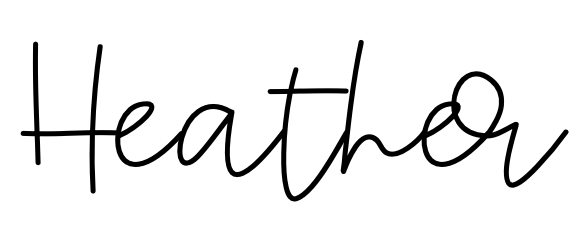
Recent Posts
Taking a Deeper Dive into Narrative Writing
The Power of Graphic Organizers for Narrative Writing
Comentários

Story Map Graphic Organizer: A Comprehensive Guide
6 minutes read
A story map graphic organizer is a powerful tool that aids writers and readers alike in navigating the complex elements of storytelling. By visually mapping out the key components of a narrative, a story map makes the process of crafting a well-structured story significantly more manageable. This comprehensive guide delves into the world of story map graphic organizers, their benefits, and how to utilize them effectively.
What is a Story Map Graphic Organizer?
A story map is a visual tool that uses a diagram to map out the key elements of a story or narrative. These elements typically include the setting, characters, conflict, plot progression (which can be further broken down into exposition, rising action, climax, falling action, and resolution), and theme.
By visually representing these elements, a Story Map Graphic Organizer helps students and writers to better understand and analyze a story. It aids in identifying relationships between different elements, recognizing narrative patterns, and predicting future events based on current plot progression.
Moreover, it can be particularly beneficial during the pre-writing stage as it assists in planning out a narrative effectively. By providing a clear outline of the story, it guides writers in developing a coherent and engaging narrative.
According to research by Boulineau et al. (2004), using graphic organizers like Story Maps can improve students' reading comprehension skills. Therefore, they are not only useful for writing but also for reading activities.
In conclusion, a Story Map Graphic Organizer is an invaluable tool for both reading and writing narratives. It simplifies complex narratives into understandable parts, making it easier to comprehend, analyze and create stories.
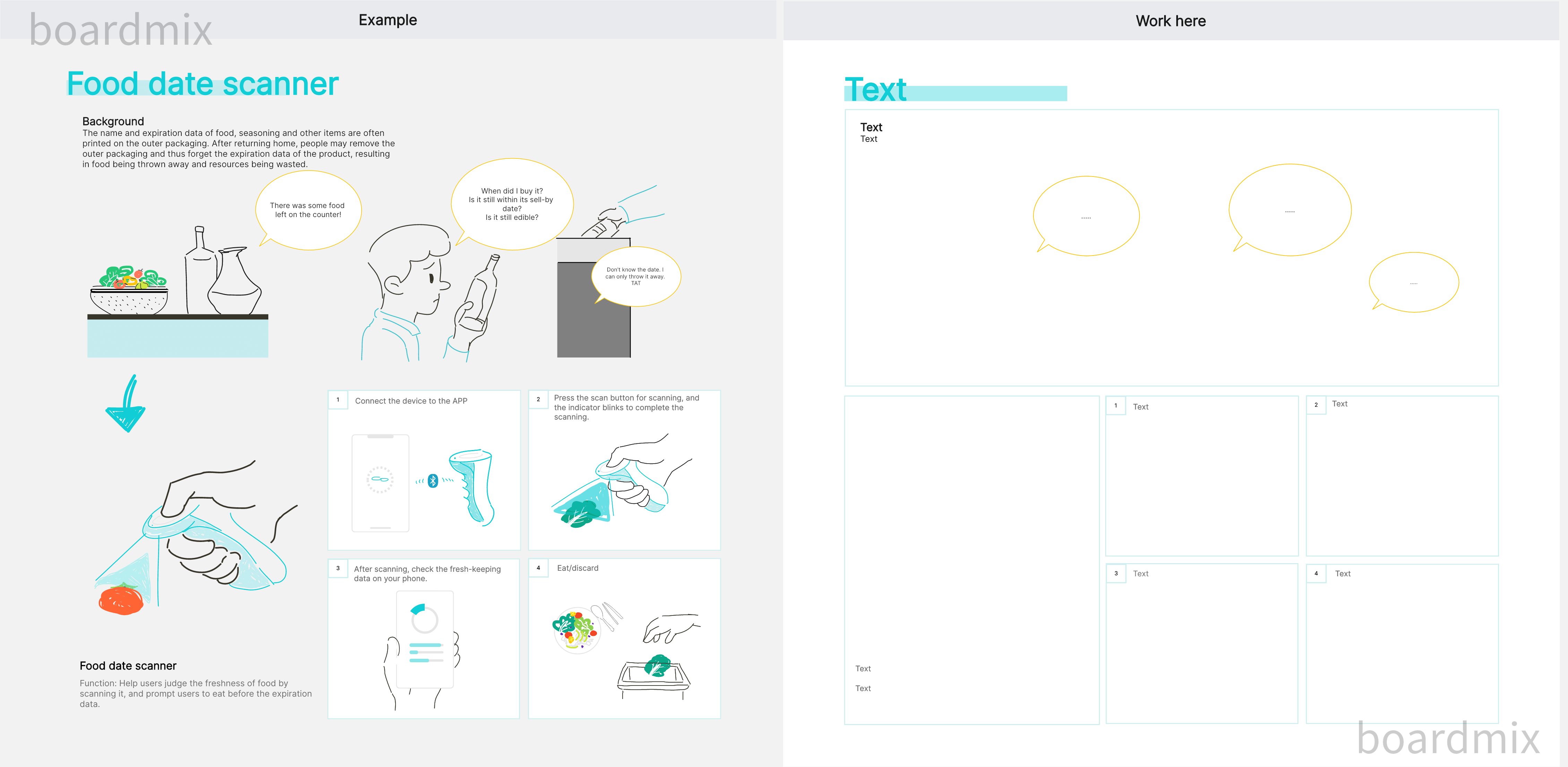
Benefits of Using a Story Map Graphic Organizer
- Enhanced Understanding: graphic organizer story map help in breaking down complex narratives into manageable parts, enhancing comprehension.
- Visual Aid: By providing a visual overview of the entire story, they assist in grasping the connections between different elements.
- Improved Writing Skills: Story maps serve as a blueprint for writing narratives, ensuring logical flow and coherence.
- Aid for Planning: They are effective tools for planning narratives as they provide an organized structure that outlines the entire story.
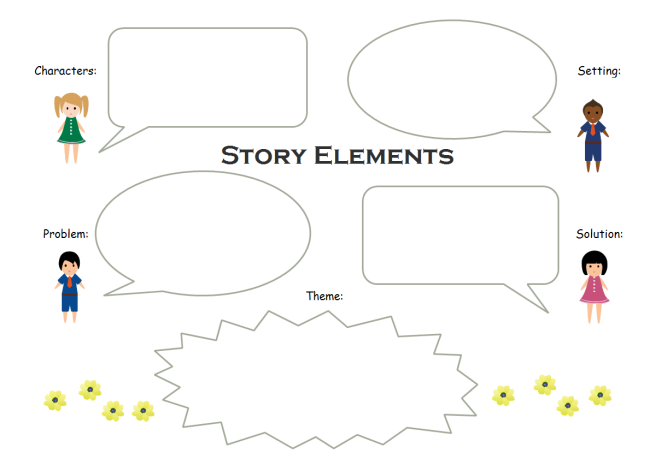
Types of Story Mapping Graphic Organizers
Story maps serve as a vital tool in understanding the anatomy of a story. By breaking down narratives into their key components, they aid in the comprehension, analysis, and composition of stories. While the central premise remains the same, story map graphic organizers come in different types to cater to varied narratives and usage requirements. Let's explore these types!
1. Basic Story Map
The most straightforward form of a story map includes a story's primary components - setting, characters, conflict, and resolution. This type is best suited for simple narratives or introducing beginners to story mapping.
2. Plot Diagram
This type takes a deeper dive into the plot structure. It divides the plot into exposition, rising action, climax, falling action, and resolution, creating a "mountain shape" diagram that visually depicts the story's progression.
3. Character Map
Focusing on character development, this organizer delves into the personality traits, motivations, relationships, and evolution of characters. It's a valuable tool for in-depth character analysis and development.
4. Conflict Map
Centered around the story's conflict, this organizer maps out the different conflicts in the story (internal/external) and how they're resolved. It helps in understanding how conflicts drive the story forward.
5. Theme Map
This type aims to identify and analyze the underlying themes of a narrative. It involves extracting symbols, motifs, quotes, and instances that point towards the theme.
6. Event Timeline
Chronologically mapping out key events in the narrative, this organizer acts as a visual timeline that aids in understanding the sequence of events and their impact on the story.
7. Multi-Story Comparison Map
Ideal for comparing and contrasting different narratives, this organizer overlaps elements from multiple stories to draw similarities or differences.
8. Interactive Digital Story Map
With technological advances, interactive digital story maps like those offered by Boardmix have become popular. They offer customizable templates and multimedia features to make story mapping more engaging and comprehensive.
How to Use the Boardmix Story Map Graphic Organizer?
The Boardmix Story Map Graphic Organizer is a revolutionary tool that enhances your narrative planning process. Whether you're an author, student, teacher, or professional storyteller, this powerful tool offers you a structured and engaging way to develop and outline your stories. So, how do you use this helpful feature? Let's find out!

Step 1: Accessing the Story Map Tool
Start by logging into your Boardmix account. Once you're in your dashboard, select the 'New Project' button. From the provided options, select 'Story Map Graphic Organizer'.

Step 2: Identify the Key Story Elements
Your first step inside the Story Map organizer should be to identify the critical components of your story. These include the setting, characters, main conflict, major events in the plot, and resolution. The Boardmix organizer will provide designated areas for each of these elements.
Step 3: Filling in the Details
Start populating each section of your story map with relevant details. Write about the setting, list down your characters, outline the main conflict, and detail the plot progression. The drag-and-drop functionality of Boardmix makes this process interactive and effortless.

Step 4: Incorporate Visuals
Make your story map more engaging and intuitive by adding visuals. You can use colors to differentiate between different characters or plot stages, insert images related to your setting or character looks, and add icons to symbolize different aspects of your story.
Step 5: Review and Refine
Once you've filled out your story map, review it thoroughly. Look for potential gaps in your plot, characters that need more development, or any inconsistencies. Boardmix allows for easy editing and refining, ensuring your story map remains fluid and adaptable.
Step 6: Collaborate
Invite others to view and edit your story map if you want feedback or are working as part of a team. Boardmix supports real-time collaboration, making it an effective tool for group projects.
Step 7: Use it as a Guide
Once you're satisfied with your story map, use it as a guide when writing your story. The clear structure and visual nature of the Boardmix Story Map Organizer make it an excellent reference throughout your writing process.
The Boardmix Story Map Graphic Organizer simplifies the often-daunting task of structuring a narrative. By allowing for a visual organization of thoughts and ideas, it makes the process of storytelling more manageable and enjoyable. Now that you know how to use it make the most of this tool and let your creativity soar!

Tips for Creating an Effective Story Map
- Keep it Simple: Your story map should be clear and easy to understand. Avoid cluttering it with too much detail.
- Use Visuals: Use symbols, colors, and other visual aids to make your story map more engaging and easy to navigate.
- Revise and Update: As your story evolves, make sure to revise and update your story map.
The story map graphic organizer is indeed an invaluable tool for anyone dealing with narratives, whether a writer crafting a new piece or a reader trying to comprehend an existing one. It provides structure to the otherwise complex process of narrative construction, making storytelling an easier and more enjoyable task. So the next time you embark on a narrative adventure, consider using a story map to guide you on your journey!
Join Boardmix to collaborate with your team.
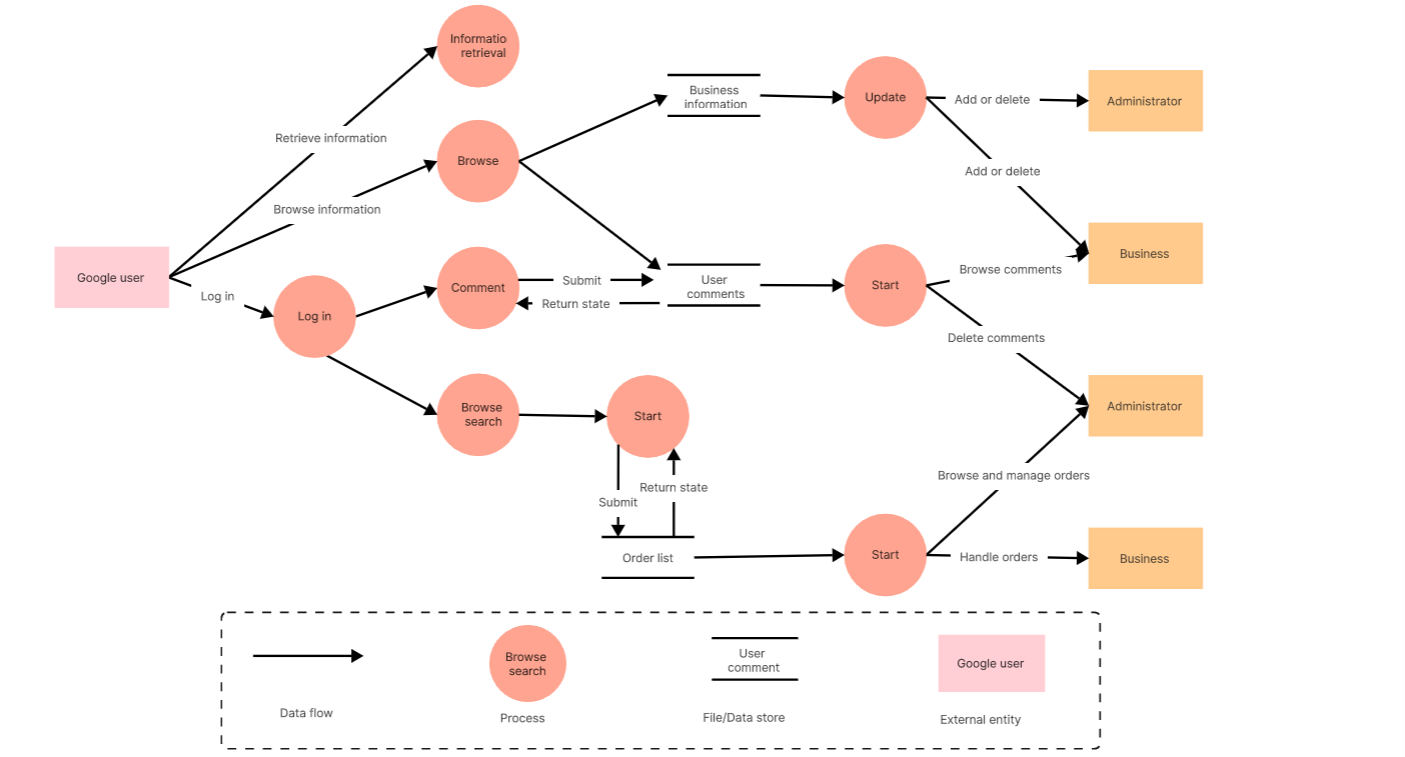
Creating Data Flow Diagrams Online: Step-by-Step Tutorial
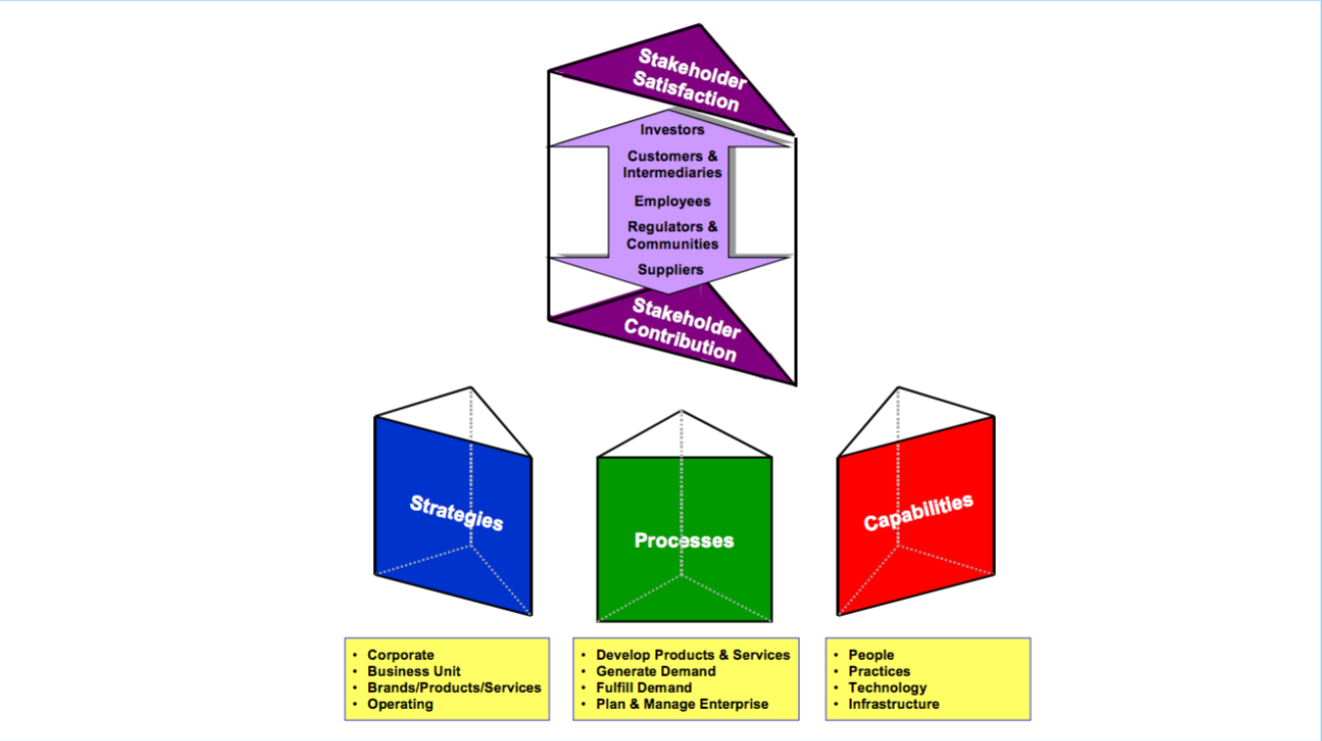
Demystifying the Performance Prism: A Comprehensive Guide
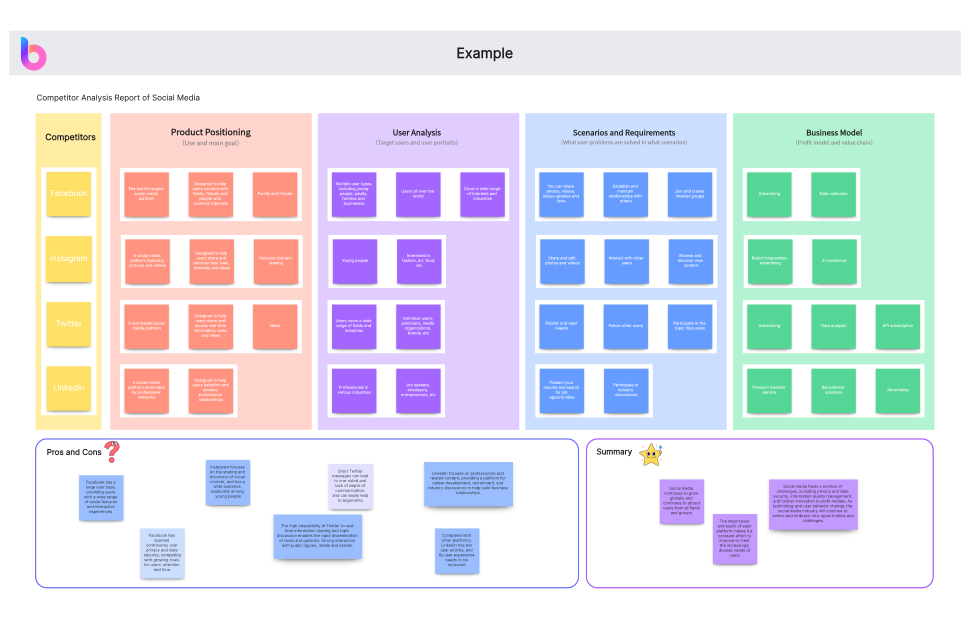
Mastering Competitive Analysis in Business Plan
Teaching ELA in the Middle
and living life one day- and book- at a time

Story Maps and Writing
When it comes to writing, students can be intimidated by it. Especially narrative writing and writing short stories. They stare at a blank page and have no clue what to write about or even where to start if they have an idea.
To help with this, I reached into my file cabinet and pulled out a graphic organizer from Education Oasis . They have a lot of different organizers on their website, and I have used their Story Map Organizer to take notes about a story and even to create their own stories.

When I introduced the students to the organizer, I had already discussed many of these plot elements. They know what each of these is about. We talk about the short stories we have already read and place those elements into an organizer. Then, I have them give me details for a story. They randomly give me setting details, character details, problem(s) and even solutions. The ending is usually a mystery on these because I plan to write and share them with the students.
By doing this, they have an idea of how to fill this out or they can borrow from mine. I even start my story on the same day by showing it to them on the overhead projector (Ipevo or Elmo) so that they know how to start their stories. Sometimes it is en media res and sometimes it is just describing the setting. I even show the other classes’ story maps that they gave me and the story I’m writing with it.
The great thing about an organizer is that students can utilize it simply even if they struggle to get started. I always take them back to the organizer if they are stuck. We fill in more details, or we work on the problem they are having. Any time we are writing, I try to sit at my small group table and allow students to come up to the table for help. Some want to camp out at the table, but unless they are absolutely having issues (I generally have on in each of my classes), they have to go back to leave a chair empty. Otherwise, I have 10 to 20 students trying to shove computers or paper in my face. And yes, it happens! Putting procedures in place for the writing conference table can be challenging the first time that I do it. By the end of the year, they know how it works and everything runs smoothly.
You may also like...

Story Time Sunday: The End is Near

The professional development we need

Middle School or High School?

Special Treat Friday
making the lives of teachers easier
Input your search keywords and press Enter.
3 Ways to Teach Narrative Writing

Why Story Maps Work!
Teaching Narrative Writing in 1st and 2nd Grade can be very easy for you and your students when you teach them how to use story maps to map out their stories.
“The story starter pictures and sentences really helped my first graders get some ideas for their writing. I like that there were variations included for lower/ higher kids.” 1st grade teacher
Step 1 Story Maps
When teachers show students how to use story maps it helps the students to be able to develop a narrative story in a much faster turnaround. Story maps help students take their thoughts and put them down on paper. Students then take these notes and use them to make a story.
As students get more and more familiar with the process, it will get easier. This is also a great method for ESL learners as there are symbols so they can easily recognize what step is next.
If you have been following along on our adventure for teaching Narrative Writing, you are in the right place for the next step. If not, CLICK HERE to go back to the first of our series in Narrative Writing.
So far students haven’t used pencils in their story writing at all. It seems strange for those who teach another way, but this is our students’ natural way of learning; talking and telling stories without a pencil.
We have been working on writing without a pencil so far, the students have used their story starter cards and they have verbally made sentences for them so far.
Now it is time to actually start writing.
I have a variety of story maps that I use for my students so that I can differentiate. I will be just introducing the simplest one here today. This is actually the best place to start with the newer writers.
As with the other concepts that have been taught, it is best to model filling out the story map first. Use your story and show how you take it from being verbal to writing it out. Model your thinking to figure out which sentence goes in each box.

You can also go step by step and you do a section and then have them do that same section.
- First, I will have the students lay out their story starter cards next to their story map.
- They say the first sentence and see which box it fits into.
- Then they will write their sentence in the box they see it fit. Most likely it is in the box with the house that says “Where”.
- Then they grab their next card and say the sentence and find where it fits. Most likely it will be in the “Who” box with the girl.
- They will keep going until they used up all the sentences in their little story that they created in their head.
We filled out the Story Map!
Step 2 rough draft.
If students use complete sentences, which I encourage them to do, they will read the sentences in their story map and can transfer it right to their rough draft paper.
Differentiation Tip
For my students who are really low, or are ESL, they might be just adding some words to their story map. For these students, it will be harder for them, but I suggest helping them to create a sentence right on their story map. This can be something that an aid or teacher would help them write at first, guiding them with the words. Once they see the pattern, you can scale back the scaffolding.
Sometimes the sentences don’t fit quite right and they need to add words to them. I also encourage students to add details at this point. The more experience they have with this concept the easier it will be to add details
Step 3 Editing for the Final Draft
This paper can be their rough draft or their final draft. I make it their rough draft because I want them to be editing it with a peer and with me. Also, the students are still trying to see how it sounds as a story. Hopefully, as they read it they will want to add more details, it does take time for them to get to that point.
The final draft will have all the new edits and will be in their best handwriting. I like to use the paper that has room for a picture on top, so they can also add a picture to their final draft. In my classroom the picture is done last, it is the dessert, and it’s also not required. Some students just don’t want to draw anything. I don’t force the issue.
Why this method works
I have found when I use Story Starter Cards and then move onto the story map and then the rough draft, it really helps my students to not only come up with ideas but start to understand the writing process. I use this method for all students to start, we do it for a few stories, at which some students are ready to move onto the next level, which is not using the story starter cards or not using all of them. This is differentiation.
I love that this method builds a foundation for students to use, when they get stuck, we can come back to the basics and practice.
I follow the Writer’s Workshop model when I do writing in my classroom. For more on how Writer’s Workshop works in the classroom, check out our article on “ How to do Writer’s Workshop” CLICK HERE or you can watch this YouTube Video that I created, CLICK HERE .

If you are interested more in How to teach Narrative Writing to 1st and 2nd grades, check out our Writing Curriculums below.
1st Grade Narrative Writing
2nd Grade Narrative Writing
1st Grade Writing Curriculum
2nd Grade Writing Curriculum
Have a Great Week!
Heather McKinsey
specialtreatfriday
Related posts.

How to use Close Reading in the Classroom

Wordless Picture Books and Story Starter Activities

Substitute Plans
No comments, leave a reply cancel reply.

Story Mountain Explained With Examples + Free Templates
Need help planning a story? A story mountain is a brilliant tool for helping new writers understand story structure and plotting.
Behind every great story is a mountain metaphor. You start off on the safe, steady ground. As you make your way up the mountain, you face many conflicts and obstacles. At the highest point, you stand proud knowing you faced the odds. Finally, you come back down, conflicts resolved, as you reach safety again at the bottom of the mountain.
You might also be interested in the snowflake method or the three-act structure for outlining story ideas.
In this post, we’ll explain everything you need to know about the story mountain technique, along with free templates to get you started!
What is a Story Mountain?
The 3 part mountain, the 4 part mountain, the 5 part mountain, 6 parts of a story mountain, 7 part mountain, extended story mountain, how to teach the story mountain, free story mountain templates.
The story mountain is a technique for outlining story ideas . It’s especially useful for children and new writers, as it illustrates the key elements of stories visually. Just like a real mountain, a story mountain illustrates the ups and downs of a story. Its key elements include the beginning, build-up, problem, resolution and ending.
It starts off on the steady ground, as the story begins. As you go up the mountain, you face many challenges and obstacles building up to the big climax or conflict of the story. Then you come down the mountain, everything settles off. Finally, you end on the steady flat ground.
There are many variations of the story mountain technique. Some are very simple, while others are detailed and complex. The simplest template contains just three elements: Beginning, Middle and Ending. While the most complex mountain we’ve seen includes seven elements: Characters, Setting, Beginning, Build-up, Problem, Falling Action and Ending. And of course, you could even break these elements down even further to create an even more detailed outline for your novel or story idea.
In the next section, we’ll explain the different versions of the story mountain with examples.
In its simplest form, the story mountain just needs three elements: Beginning, Middle and Ending. Each element has been explained below:
- Beginning: What will happen at the start of the story? Where is it set? Who are the characters?
- Middle: What is the major event in this story? How does this event happen? What problem/s will the characters face? How are these problem/s created?
- Ending : How will the story end? What choices will the main character make? How will the problem/s be solved? Are there any lessons to be learnt?
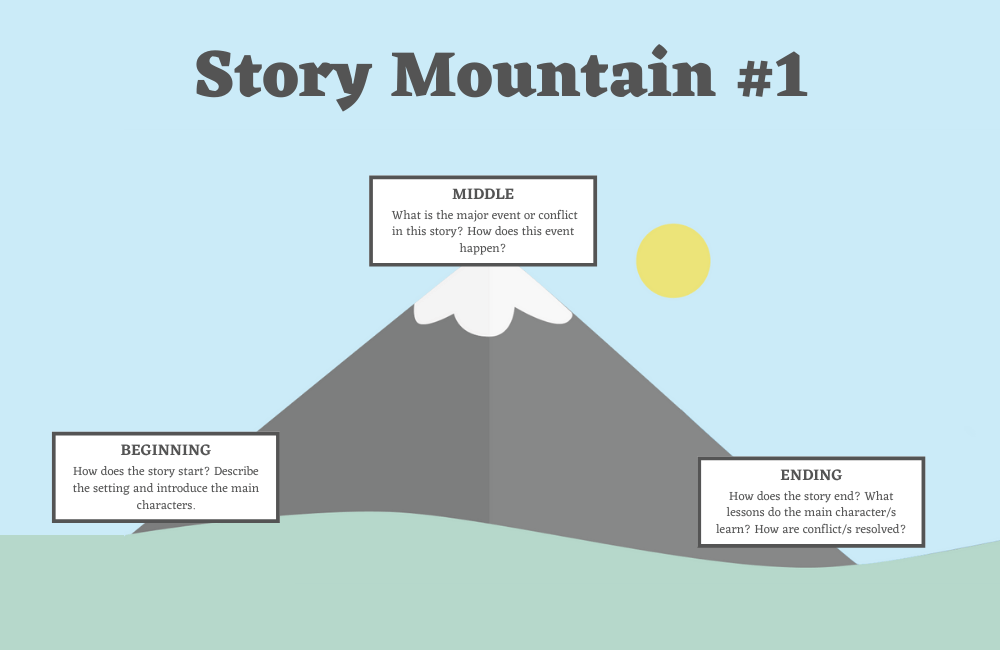
Below is an example of a completed template using the story of Little Red Riding Hood:
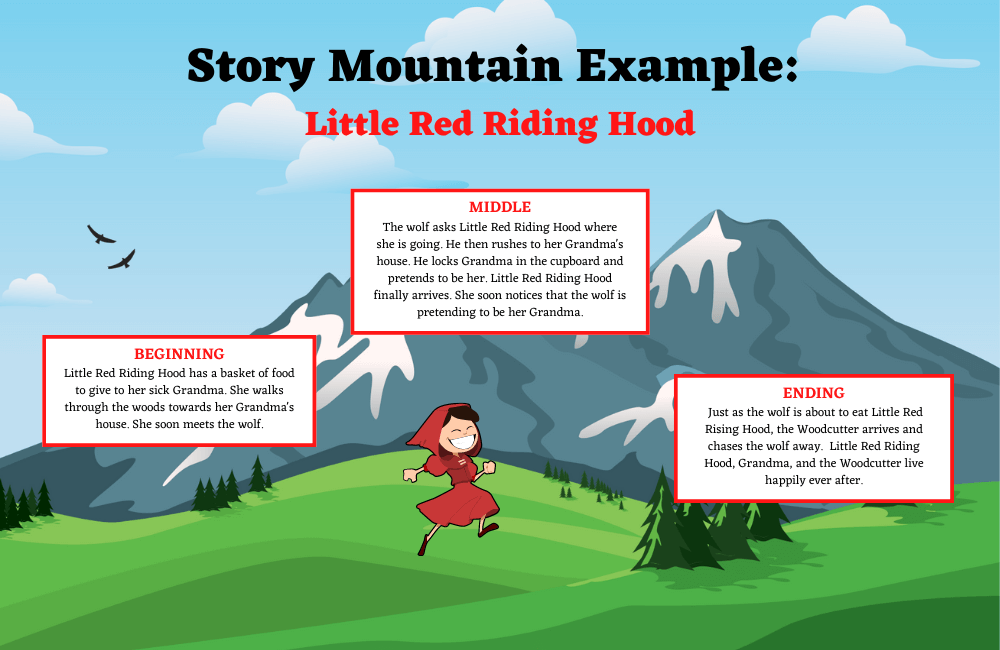
The story mountain can also be divided into 4 parts: Beginning, Middle, Falling Action and Ending:
- Beginning / Rising Action: How does the story begin? Introduce the characters and settings. How is the conflict or problem created?
- Middle / Climax: The main character/s must face the conflict. How will they resolve it?
- Falling Action: Explain what happens after the conflict.
- Ending: How does the story end? What lessons do the characters learn?
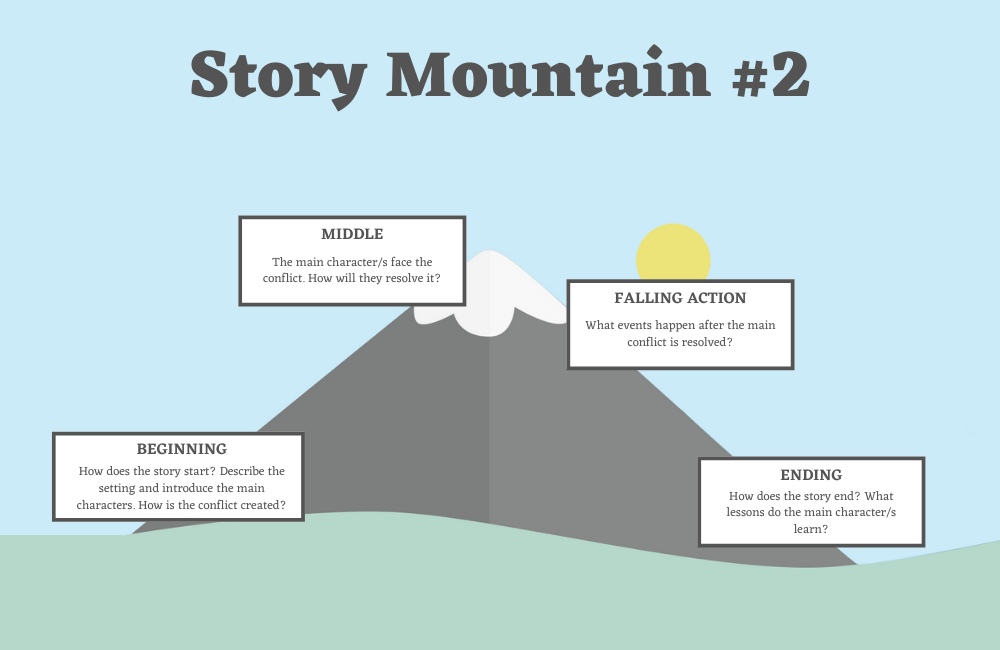
Example of Little Red Riding Hood using the 4 part template:
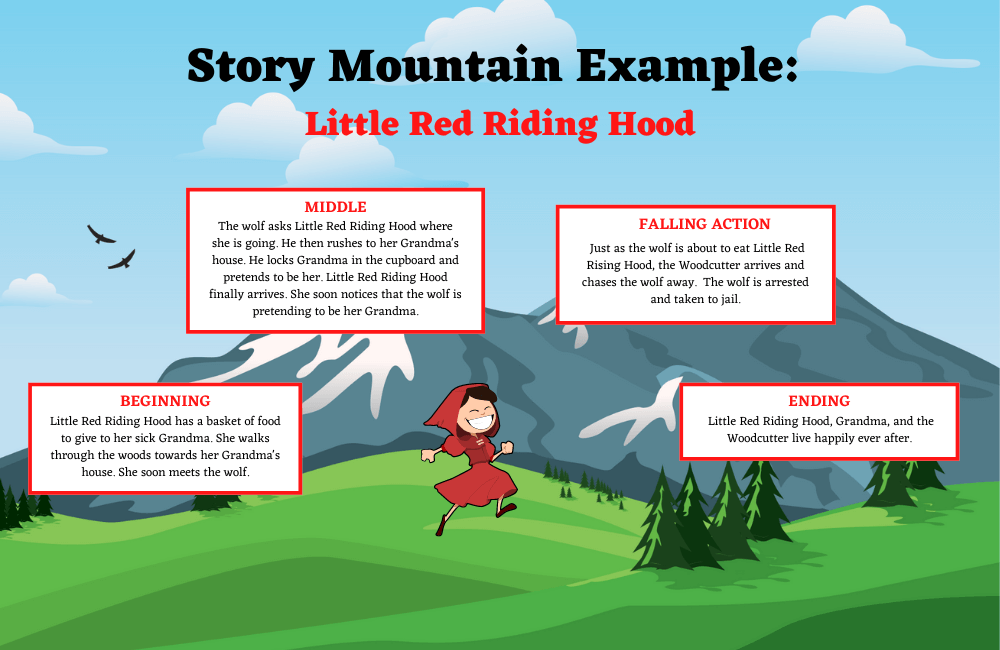
The most common type of story mountain template contains five elements: Beginning, Build-Up, Problem, Falling Action and Ending:
- Beginning: How does the story begin? Describe the setting and introduce the characters.
- Build-Up: This is also known as the rising actions. What events will happen before the major conflict takes place?
- Problem: The problem or climax is where the major conflict actually happens.
- Falling Action: Also known as the resolution. Describe how the main conflict is resolved. What happens after the conflict?
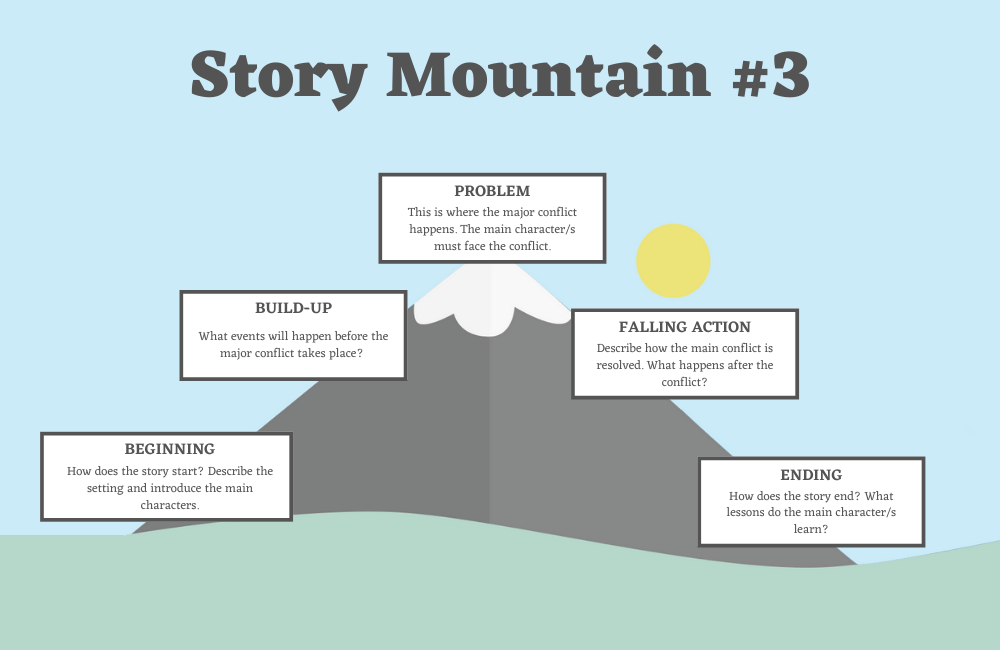
Example of the five-element mountain using Little Red Riding Hood:
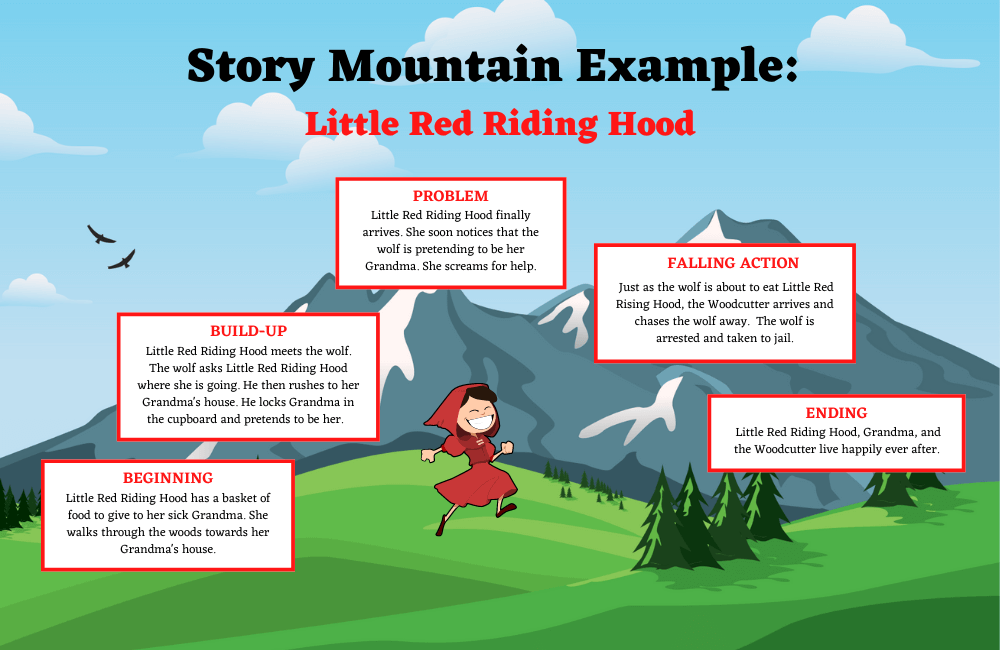
The six main parts of the story mountain include Beginning, Unexpected Event, Build-Up, Problem, Falling Action, and Ending:
- Beginning: How does the story start? Introduce the main characters and describe the setting.
- Unexpected Event: Think about how the major conflict is created, and why? In other words, what event happens to cause the conflict?
- Build-Up: What events happen before the major conflict?
- Problem: This is where the major conflict happens. The main character/s must face the conflict.
- Falling Action: How is the conflict resolved? What happens after the conflict is resolved?
- Ending: How does the story end?
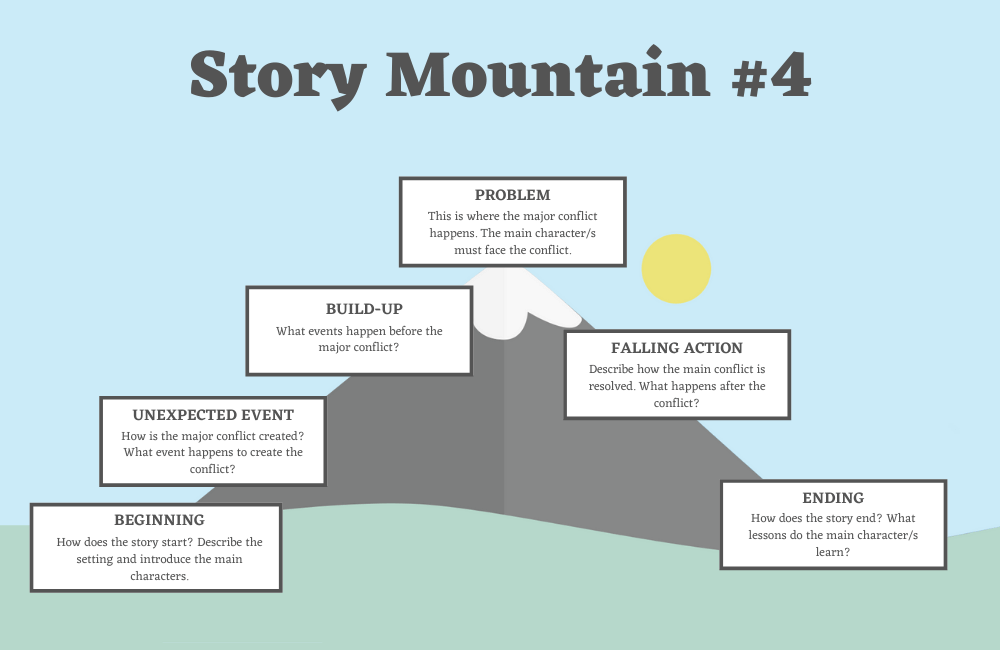
Six-part example using the Little Red Riding Hood story:
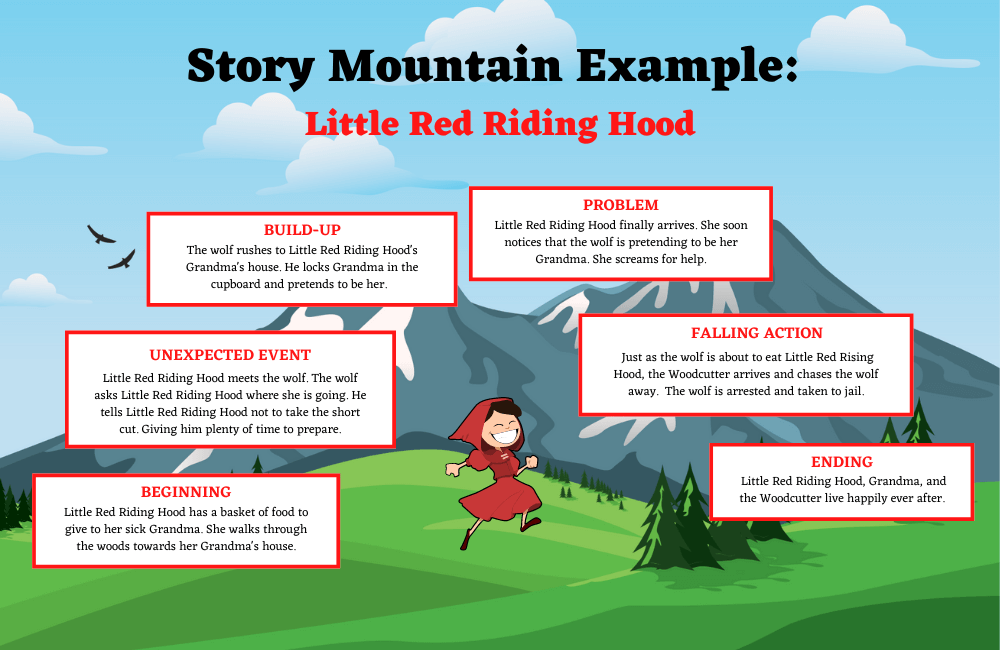
Some story mountain templates have seven elements included: Characters, Setting, Beginning, Build-up, Problem, Falling Action and Ending.
- Characters: List and describe the main characters in the story.
- Setting: Describe the main setting of the story. Think about the time period, mood and even location of the story.
- Beginning: How does the story begin?
- Build-up: What events take place before the main conflict?
- Problem: Describe the main conflict? How do the main character’s deal with this conflict?
- Falling Action: What events happen after the conflict is resolved?
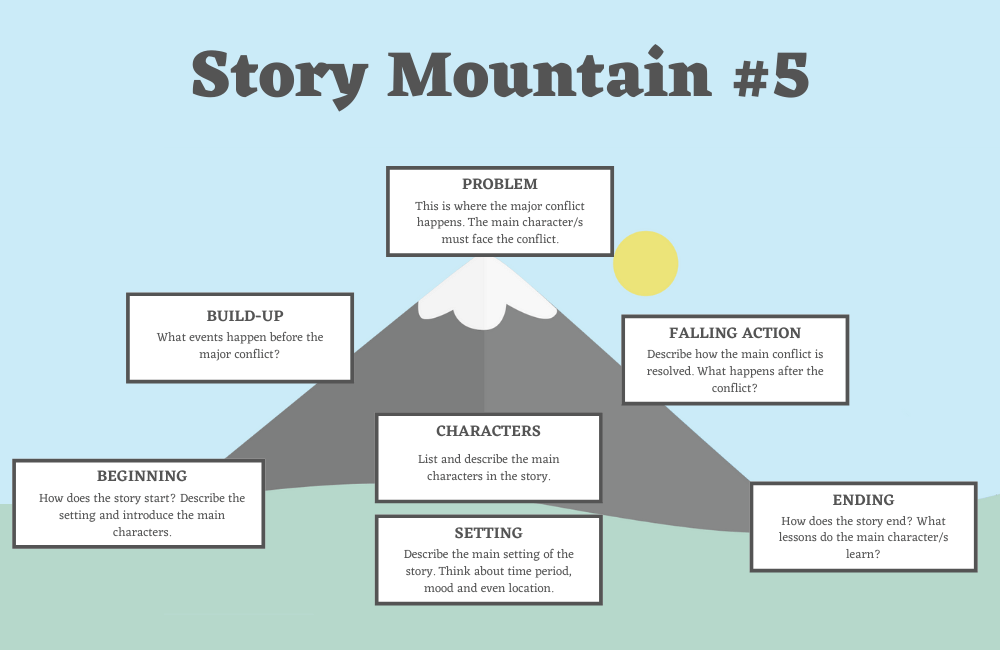
The seven-element template example using the tale of Little Red Riding Hood:
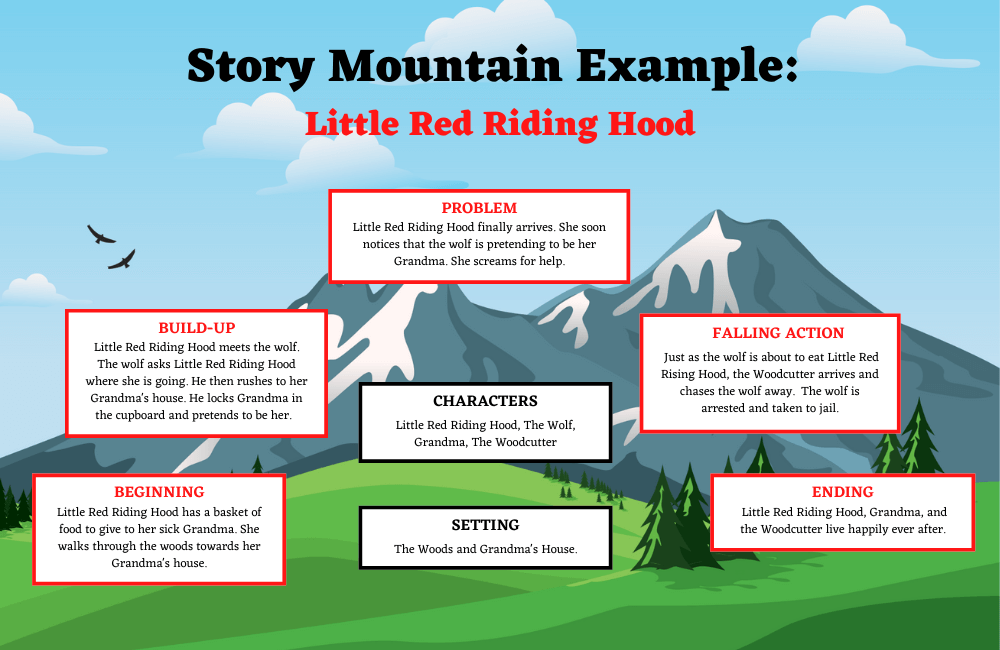
The mountain template can be extended to outline complex story ideas with multiple conflicts. For example, for a story with two major conflicts, the mountain would go up, down, up again and then finally down. The key elements could be adapted to the following seven elements:
- Beginning: What happens at the start of your story?
- Build-Up: What events happen before the first major conflict?
- First Problem: How do the main character/s deal with the first conflict or problem?
- Falling Action: What events happen after the first conflict is resolved?
- Second Problem: The main character/s face another conflict. How do they deal with this second major conflict?
- Falling Action: What events happen after the second conflict is resolved?
- Ending: How does the story end? What lessons are learned?
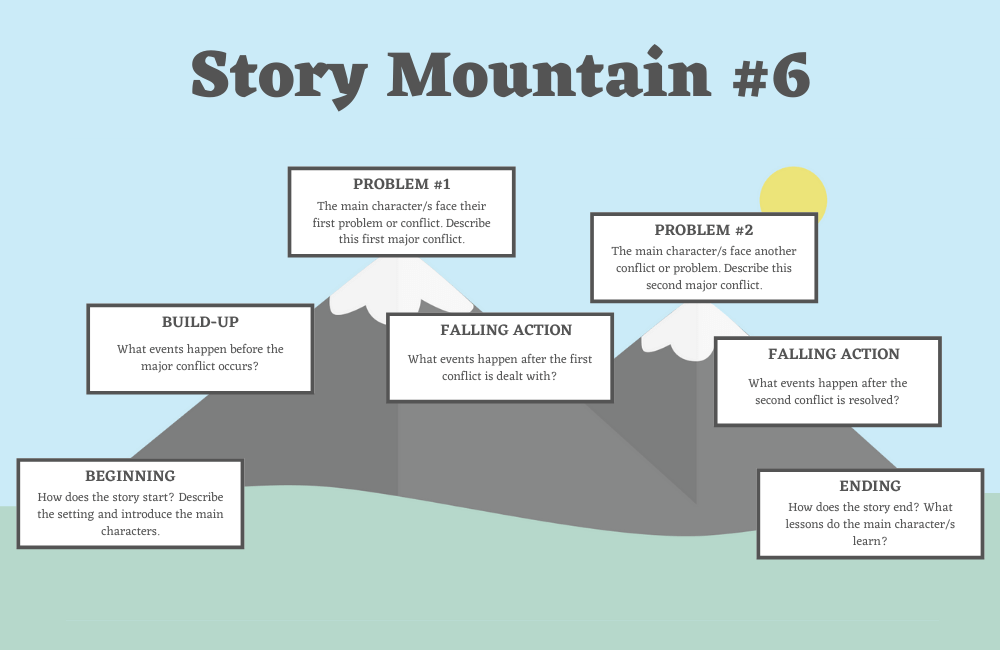
Example of the extended technique using Little Red Riding Hood:
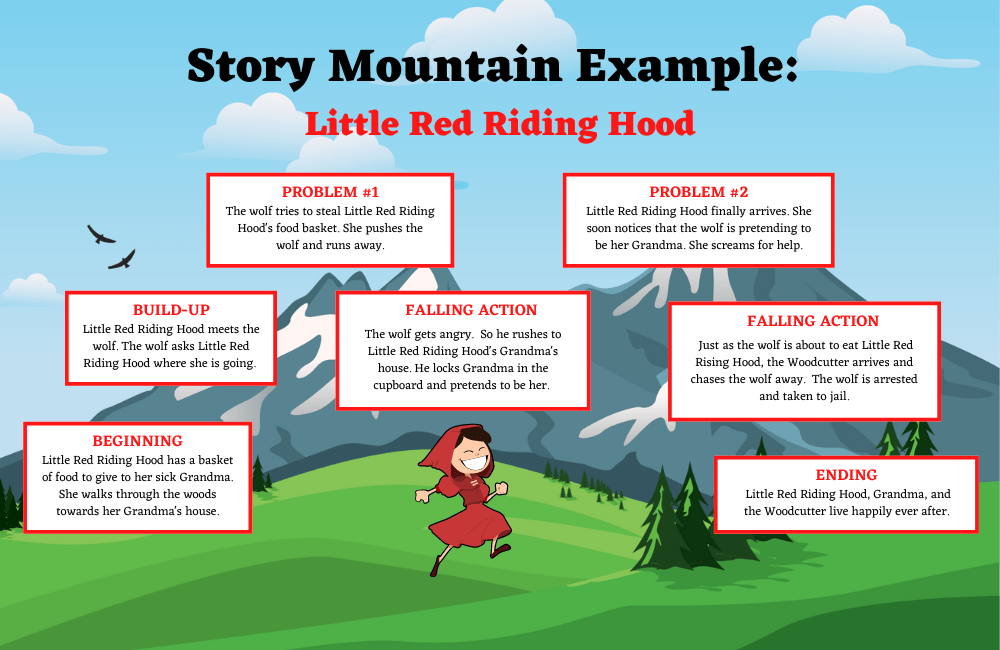
The story mountain is one of the earliest outlining techniques used in classrooms between KS1 to KS3 or grades 1 to middle school . Compared to other plot outline techniques, this technique is not only visually appealing but simple enough for early writers to understand. There is a number of ways to teach the story mountain in classrooms, such as:
- Complete a blank template based on the student’s favourite book.
- Have a whole-class discussion on how to complete the story mountain together for a popular story or movie.
- Working in small groups to complete a blank template for a popular movie or book.
- Using the student’s own story idea, use the template to plan this idea in more detail.
- Provide a list of scenes from a popular book or movie. Together as a class or in small groups, put the scenes in the correct place on a blank template.
When it comes to teaching the story mountain to students, we recommend you use a worksheet or template. Print one blank template for each student in your class. Along with the blank template, include a completed example that students can reference when completing their own blank template.
Your next task as a teacher is to explain each element of the template, along with examples. First start with the beginning, explain this element and then give your students around 10 minutes to complete this section. Then move on to explaining the next element, and give your students another 10 minutes to complete that section. Keep going until all the sections are complete.
As homework, you could give your students another blank template to complete for a book they recently read in class or even a movie they recently watched. Using their favourite book or movie as an example is a great way to engage reluctant writers into completing the task. It also helps them grasp the concepts of the story outlining process, as they’ll be able to visually see how their favourite book or movie is broken down.
An extra tip here is to tell the students to write down a list of key scenes from the book or movie first. The students can then pick at least one scene for each element of the story mountain. And then finally they can plot these scenes on the mountain in the correct order.
Now that you know how to use the story mountain template, it’s time to practice this technique yourself! You can download the different versions of the template below. Each template includes a completed example and a blank story mountain template:
- 3 Part Mountain Template
- 4 Part Mountain Template
- 5 Part Mountain Template
- 6 Part Mountain Template
- 7 Part Moutain Template
- Extended Story Mountain Template

Did you find this post on the story mountain technique useful? Let us know in the comments below.
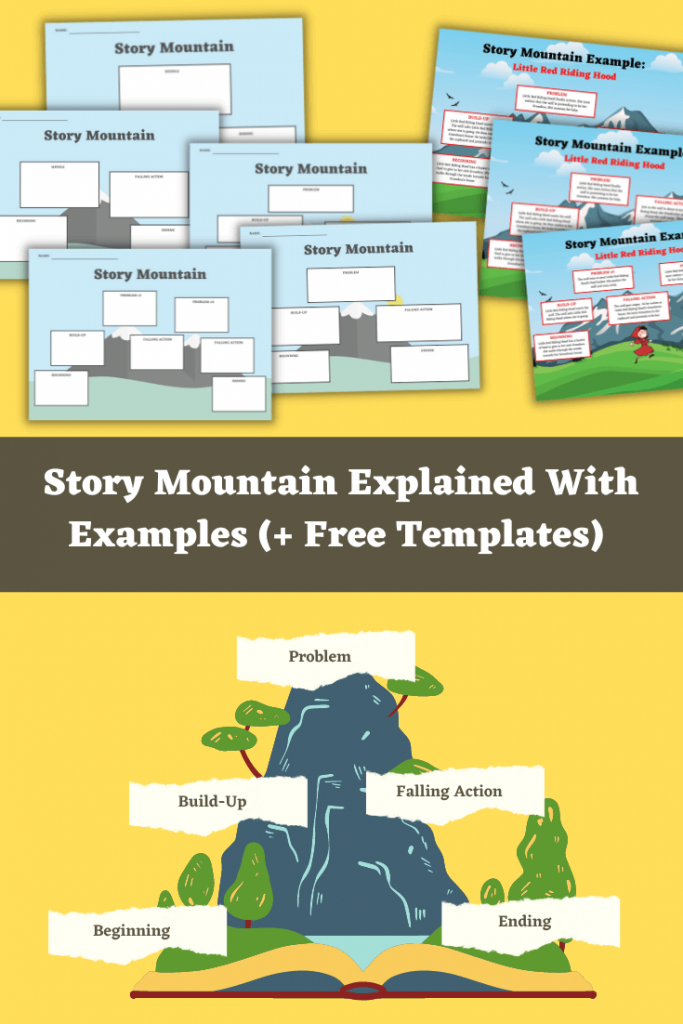
Marty the wizard is the master of Imagine Forest. When he's not reading a ton of books or writing some of his own tales, he loves to be surrounded by the magical creatures that live in Imagine Forest. While living in his tree house he has devoted his time to helping children around the world with their writing skills and creativity.
Related Posts
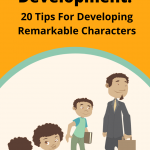
Comments loading...
fictional story map
All Formats
Resource types, all resource types.
- Rating Count
- Price (Ascending)
- Price (Descending)
- Most Recent
Fictional story map
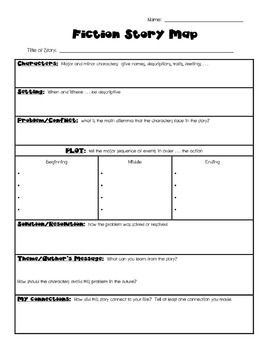
Fictional Story Map for Elementary Students

Fictional Book Talk with Story Map (3-5)

NARRATIVE WRITING BUNDLE: Fictional Story Map

- Google Docs™
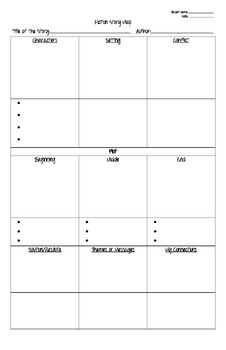
Fictional Story Map

Fictional Narrative Story Map

Snowman Story Map Mobile
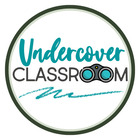
Fictional Narrative Writing Powerpoint Writing Workshop
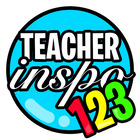
- Google Slides™
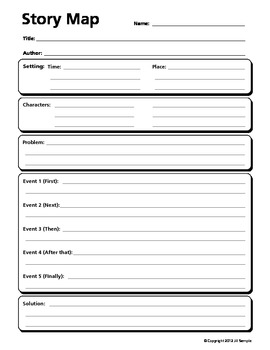
Story Map - Outline for Story Writing

Reading Comprehension: Story Elements with Story Map / Graphic Organizer

The Rough-Face Girl- Plot Map Activity, Vocabulary, Character Analysis, STAAR
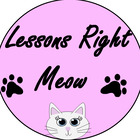
Story Elements Map : Spanish and English

March Fictional Narrative Writing | St. Patrick's Day Writing | Bulletin Board
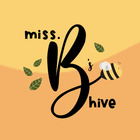
NARRATIVE - Creative Writing - Brainstorm Using Story Cards - ALL(9) Genres!
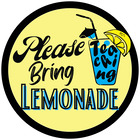
Narrative Writing Story Plot Map

Winter Story Element Graphic Organizers | Story Element Worksheets

NARRATIVE - Creative Writing - Brainstorm Story Cards - SCIENCE FICTION Genre!
- Google Drive™ folder

The Three Billy Goats Gruff with Fictional and Nonfictional Texts

Narrative Prewriting Story Map

Story Plot, American Revolution; ELA/SS; Plot Map

Story Plot; Civil War; ELA/SS; Plot Map ;
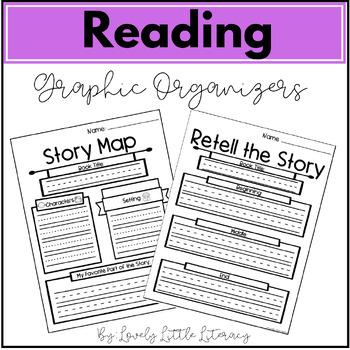
Reading Graphic Organizers Story Map Freebie

CKLA Knowledge Domain 3: Ancient Greece Fictional Narrative

NARRATIVE - Creative Writing - Brainstorm Story Cards - REALISTIC FICTION Genre!
- We're hiring
- Help & FAQ
- Privacy policy
- Student privacy
- Terms of service
- Tell us what you think

IMAGES
VIDEO
COMMENTS
A story map is a graphic organizer that helps students learn the elements of a narrative. Learning to identify a story's characters, plot, setting, problem, and solution prompts students to read carefully to learn the important details. There are many different types of story maps. The most basic ones focus on the beginning, middle, and end ...
In this video, you'll learn how to create a story map to help plan your narrative writing! Your story map will include characters, setting, and plot events i...
The Story Map interactive includes a set of graphic organizers designed to assist teachers and students in prewriting and postreading activities. The organizers are intended to focus on the key elements of character, setting, conflict, and resolution development. Students can develop multiple characters, for example, in preparation for writing ...
A narrative can spark emotion, encourage reflection, and convey meaning when done well. Narratives are a popular genre for students and teachers as they allow the writer to share their imagination, creativity, skill, and understanding of nearly all elements of writing. We occasionally refer to a narrative as 'creative writing' or story writing.
Inside there are blackline masters of both versions (the story map and the plot diagram), Plot Diagram anchor chart, and teacher exemplars to help you with planning and setting reading and writing expectations for your students. Happy writing, my friends! Plot diagrams are a great way to help improve your students' narrative writing.
A story map graphic organizer is a powerful tool that aids writers and readers alike in navigating the complex elements of storytelling. By visually mapping out the key components of a narrative, a story map makes the process of crafting a well-structured story significantly more manageable. This comprehensive guide delves into the world of ...
0:42. In this example, we'll construct a story map for Kate Chopin's "The Story of an Hour.". 0:48. First, write down the title and the author or authors of the story. 0:54. After that, list the characters, making a note of the main characters. 1:02. Describe the setting—the place and time of the story. 1:09.
In this video, you will learn how to make a plan for your imaginative narrative using a story map! We will plan the characters, setting, and events, includin...
Narrative Flow Map. The narrative flow map presents a different way of diagraming the plot. It is essential that students work through each element of their story before they start writing. Otherwise, the narrative may contain unnecessary elements or skip over critical components that are needed for a cohesive storyline.
When it comes to writing, students can be intimidated by it. Especially narrative writing and writing short stories. They stare at a blank page and have no clue what to write about or even where to start if they have an idea. To help with this, I reached into my file cabinet and pulled out a graphic organizer from Education Oasis.
Story Map is an interactive tool that sssists students in prewriting and postreading activities by focusing character, setting, conflict, and resolution.
Make a chart of the elements of narrative structure. Lower elementary children first begin to learn story mapping by identifying and describing what happens at the beginning, middle, and end of a story. For older students, divide the chart into segments labeled as shown: The events and the resolution may be repeated in complex stories or novels.
Narrative Story Map Template. ... Students can refer back to their story map when preparing for an exam or when writing an essay, and be able to clearly identify specific aspects of a text. ... Use story maps whenever you read a novel as a class Once students are confident using story maps, you can use them more frequently in class. Students ...
Step 1 Story Maps. When teachers show students how to use story maps it helps the students to be able to develop a narrative story in a much faster turnaround. Story maps help students take their thoughts and put them down on paper. Students then take these notes and use them to make a story. As students get more and more familiar with the ...
7 Part Mountain. Some story mountain templates have seven elements included: Characters, Setting, Beginning, Build-up, Problem, Falling Action and Ending. Characters: List and describe the main characters in the story. Setting: Describe the main setting of the story. Think about the time period, mood and even location of the story.
The story maps and narrative writing planners are a great way to motivate reluctant writer.A great addition to:literacy centerswriting centersliteracy lessons writing lessonsassessment tasksDepending on student ability, this set is suitable for First grade, Second Grade, Third Grade and Fourth Grade. ...
Plot Diagram, Narrative Writing Map, Story Map. This is a fun graphic organizer to help students better understand plot structure when writing short stories or long narratives! It can also be used for students to map out details from a story they have read. I hope your students enjoy as much as mine have.This product is also now available as a ...
Narrative Writing Story Map. Created by . Room 306B. This outline helps young writers use an outline for their narrative writing pieces. It allows them to remember to include all the story elements that you would expect from a narrative sample. Subjects: Creative Writing, Special Education, Writing.
These story map templates can be used in isolation, or you could provide your students with several templates in sequence for a more detailed and multi-level approach to planning a narrative. Whichever story map template your Year 1 learners prefer, it will give them a great framework for planning and writing their creative pieces.
A story map is great to use when writing down ideas for a story, or parts of a topic. They can show the characters, themes, plot, settings, problems, and solutions of a story. Story maps provide a helpful visual aid for younger children. This pack of story map worksheets offers a variety of different sheets that ask children a bunch of questions to prompt their writing technique. These sheets ...
Whether through writing, speaking, or visual storytelling, storytelling is a powerful tool that can help us connect with others, communicate our ideas, and inspire change. You can teach your students to interpret written texts, to organize and map out their story ideas with our story plot diagram!
Use these graphic organizers to help students in organizing and planning their narrative, persuasive, and expository writing . Includes: 1) Narrative Planning Map: characters, setting, beginning (problem), middle (1st and 2nd attempt at solving problem), end (solution to problem). 2) Persuasive Planning Map: position on topic, reason 1-3 ...
NARRATIVE WRITING BUNDLE: Fictional Story Map. This is a story map to help students plan out a fictional narrative piece. This works best if it is broken down into several days with mini lessons in between. Using this document, students will plan the characters, setting, conflict & resolution, theme, and plot events.